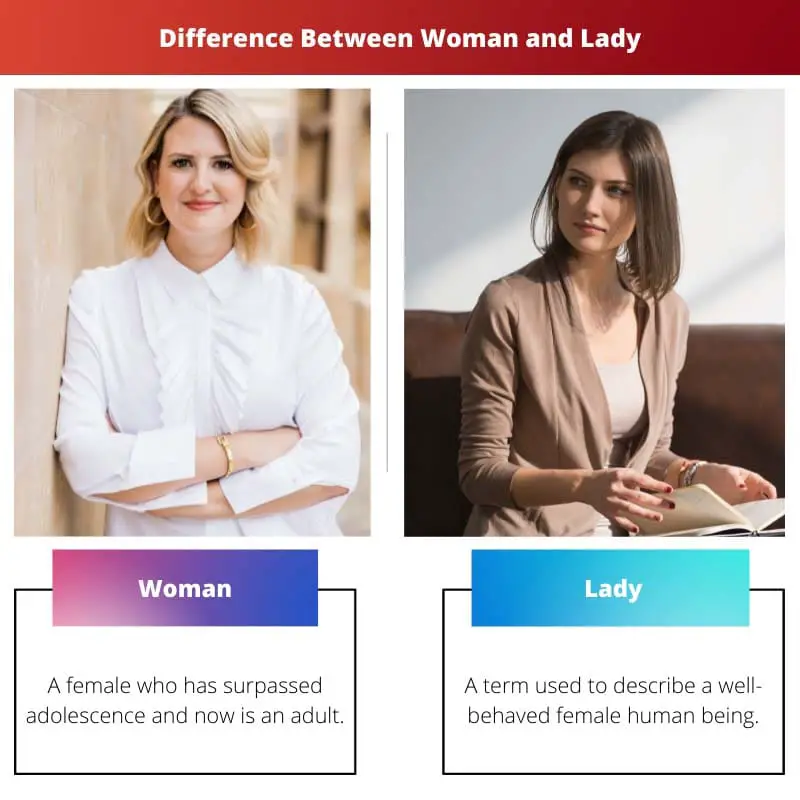“All girls can become women, but not all women can become a lady.” This is a famous quote used to differentiate between the two nouns used to describe the female gender of the human race.
Though people may think a Woman and a Lady are synonymous with each other, both the words used to identify a female have a slight difference between them. However, The use of these words depends on the situation, the context of the speech, and the person speaking something.
Key Takeaways
- The woman refers to an adult female human, while Lady refers to a woman of high social position or a polite term used to address a woman.
- A woman is a neutral term that can describe any adult female. At the same time, Lady is a term of respect and implies certain characteristics such as refinement, elegance, and grace.
- Women can be used professionally or casually, while Lady is more commonly used in formal situations.
Woman vs Lady
When a woman is addressed in a proper chivalrous manner, the term Lady is used. Lady is the courteous way to refer to a female. The noun woman is used to mention a grown-up female. It is used to refer to a female of age. Both terms are employed as a noun and can’t be used synonymously.

Woman, a two-syllable word, is used to name a female human being. A particular girl has to be over the official age of being an adult, that is, 18, in most countries of the world, to be called a Woman. The word has been in use since the 1300s.
Lady is another word used to identify an adult female. It is assumed that a Lady is more well-behaved and respectful comparatively. It was popular in earlier times to call the wife of a duke or a queen/princess a Lady.
Though it depends on the person speaking, now Lady is not only limited to royalty and is used in normal conversations as well.
Comparison Table
| Parameters of Comparison | Woman | Lady |
|---|---|---|
| Definition | A female who has surpassed adolescence and now is an adult. | A term used to describe a well-behaved female human being. |
| Word came from | Old English word “wifmann” | The old English word “hlæfdige.” |
| Characters | Five | Four |
| Plural form | Women | Ladies |
| Another meaning | A certain type of title or job position in an institution or any other working place. | A title that is given to a woman of high class/society. |
| Example | Chairwomen, Frenchwoman, etc. | Lady Diana Spencer, First Lady, Cleaning Lady, etc. |
What is Woman?
A Woman can be used to call a female above eighteen years of age but preferably is used for above twenty-five years. The word arises from the old English word “wifmann,” which translates into “woman-person.”
The word progressed from wimann to wumman and, ultimately, became Woman.
There are many phrases that use the word Woman. Women’s Rights is one of the most used Woman Phrases. It is used to identify a feminist movement from the 19th century.
Unlike Lady, it is not used as a Royal title but is used to describe job titles like Chairwomen, etc. And in certain places, especially in the United States, it is used in anger by people in a fight or in an offensive way, like “Shut up, Woman.

What is Lady?
A Lady is a word used to signify a female. It is a more polite and respectful way to address an adult female.
The word came from the old English word “Hloefdige,” meaning “loaf Woman” in earlier centuries, it was used only for royals and for the wives of Dukes, who used to be homemakers. It is compared to a gentleman, meaning it is considered more royal is compared to a Woman.
Another use for the word can be as a title to show respect and honor the woman in a royal family in the United Kingdom, for example, Lady Diana Spencer, who was the Princess of Wales.
And in the United States, it can also be used as an offensive way to call out a girl, for example: “Calm down, lady!”
To identify a female below 18 years, another term, “young Lady,” is used, and for an elder lady, “Old Lady.” Unlike Woman, this term has evolved, and there have been changes in its meaning, now, it does not adhere to royal titles only but has been updated to form many new meanings.

Main Differences Between Woman and Lady
- Lady is a more sophisticated or, rather, a more posh word that is used to describe a woman. On the other hand, a Woman, though equal to a female adult as well, is considered somewhat more ordinary and less than a Lady.
- Lady is also used to represent certain terms as well, like First Lady and in titles of some royal families. Though this is not that popular in today’s world, it is used now as well, just in a smaller number. A Woman is not used in these royal titles.
- In scientific research and newspaper reports, Woman or female is the word that is used to describe the information or the incident. The word Lady is not used for this purpose.
- A woman is a gender used to describe a female human. On the contrary, Lady is a term used to represent a well-behaved female.
- At first, Lady was used to describe a female who used to do household chores and a female who married a duke. The word is revolved now, and the meaning has now changed. On the contrary, Woman has retained its meaning that signifies an adult female human being.




